Bilal Zuberi
As a writer, I often encounter my sources for inspiration in my daily life; I don’t hunt it down, but it finds me. However things were markedly different when I wanted to interview Mr Bilal Zuberi. I was introduced to Bilal in Lahore in 2013 through a colleague. When I came to know about Bilal’s artistry, based in an Islamic ethos but with a boundless vision for creativity, I instantly wanted to know more. However Bilal’s schedule rarely coincided with mine, so it was quite a bit later that I actually got to sit down and talk about his work.
Bilal Zuberi is a Lahore-based artist, owner of Jharonka interiors designs and Jharonka Art Studio, the Exclusive Institute of Fashion and Art, and chairman/president of the Culture and Art Familiarity Development Foundation.
Bilal’s busy schedule is indicative of his position in the arts scene. As one of the brightest stars in Lahore’s arts scene, his typical day is packed with meetings, teaching class, mentoring, and of course painting. Dressed smartly, he ushers me into the office of his interior design firm in one of Lahore’s leafy upmarket districts. The corridors of the firm are all sleek slate, backlit reflective glass and modern hints of chrome. Quite impressive, I comment.
“Thanks” he replies, a shy smile spreading across his face. “I’ve had this for two years now, with my brother” he motions towards a glass-walled room where a meeting is taking place.
So where could I see some of your work, I ask.
He lists a number of important mosques, followed by “Zero Point Wagah”; he rattles off a list of achievements rather nonchalantly. He hands me a folder of pictures showing a wooden panel wall emblazoned with calligraphy so bold it could almost be graffiti, were it not so precise and sacred.
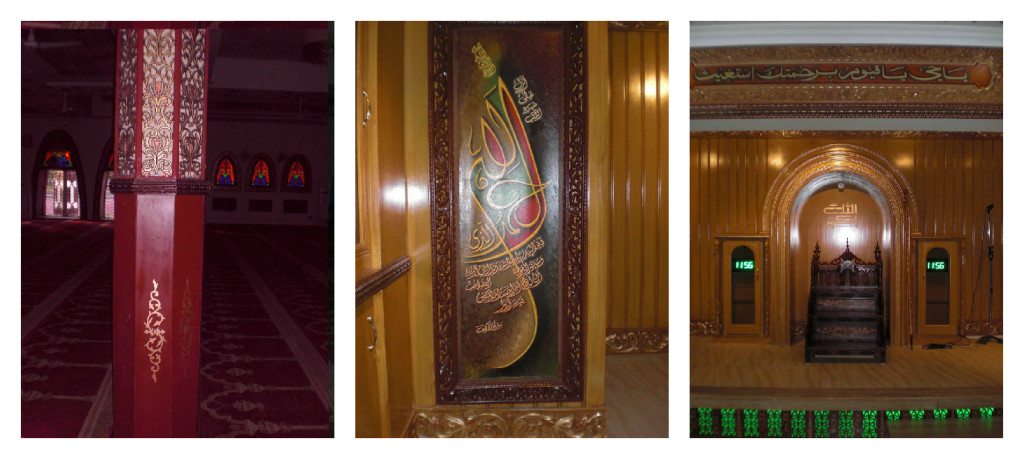
Bilal Zuberi’s works in various mosques.
As I flick through the album, I come across a picture of a modern building still under construction, with similar but more contemporary calligraphy across its facia.
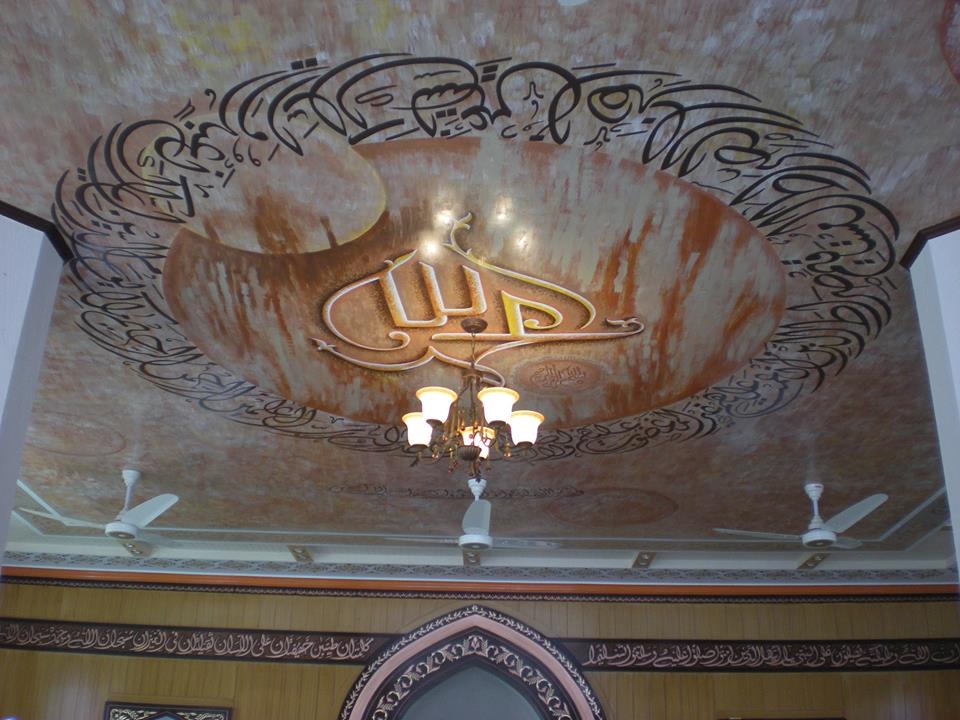
Some of Bilal’s calligraphy work
Obviously Islamic calligraphy is his forte, and the success of this is modern Pakistan is not surprising. I wonder what Bilal’s assessment of the arts scene in Pakistan is.
“The problem is that Pakistanis tend not to distinguish between commercial and professional art” he muses. “That’s one of the main reasons why it’s not successful. Art is a business in Pakistan, but in sha Allah that will change. “Art should be priceless. People here don’t distinguish between different strands of art – musical, visual or whatever.”
All of this leads me to one obvious question; why did he go into art?
“I studied chemical engineering!!” laughs Bilal. “But it wasn’t for me. Six years ago I took admission in the National College of Arts and graduated in textile design.” He shows me another set of photos, this time depicting his college. He points to two men in the pictures;
“Saeed Akhtar and Khalid Akash… two of my teachers… they were particularly important for me… they really taught me a lot” he says with a serious tone. “I was always interested in art, but it really only took off with two major projects in 2011. I had my first solo exhibition at the Meraj Art Gallery at the Hotel Meraj in 2011.” So it has been quite a fast ascent for him then?
“These days I only sleep for four or five hours per day, and even then I dream about my art” he replies.
If art takes love, then charity takes dedication, and to start a charitable organisation concerned with art would have to be a labour of love.
“Many artists are wasted in Pakistan” says Bilal, looking me directly in the eyes. “Sindhi artists, from Rahim Yar Khan, Saraiki region, the Northern Areas… this is the main disaster of our country. And the leadership is to blame – too much corruption, not controlling terrorism…” So what is it that he actually does?
“I work with a lot of budding artists in the Saraiki belt of southern Punjab” says Bilal. We want to nurture Pakistan’s art and cultural history, and introduce it to the Middle East in sha Allah. We have exhibitions in Lahore, at the Alhamra Arts Studio. As well as that, I have about fourteen students who come to my studio from the NCA, Punjab University, Beaconhouse, the Institute of Fashion and Textile Design… they come to develop their final theses.” This all sounds quite admirable, but what kind of support does he receive for it?
“Donations. Donations help to keep the NGO alive. And I work at the office or teaching Monday to Saturday, and I work with the NGO on Sunday.” Speaking about the NGO, I noticed a shift in Bilal’s tone. Where up until now, he had been overwhelmingly humble, and almost shy, speaking about his charitable work seems to bring out a drive in his voice and a determination in his demeanour. My next question would only add to this.
“Why is art important, particularly in Pakistan nowadays?” I already know the answer to this question.
“Artists are peaceful ambassadors” theorises Bilal. I’m immediately reminded of his work at zero point on the Wagah border, his relief on the very border between Pakistan and India, just 30 kms from where we are sitting now.

I ask Bilal about his family, and their reaction to his choice of path in life; undoubtedly an unorthodox one when one considers the pressure to pursue a career in more academic fields.
“My father was involved with movies…” says Bilal with a smile. “He invested in Dushman Ho To Assa, and some other movies…” So he is artisticaly-minded too, I ask? He nods cautiously.
“A couple of years ago he had a brain harmmorage. Since then he has become more religious, and much more interested in Islamic art. He doesn’t really understand the art of fashion…” Bilal motions towards his folder of fashion designs, sitting on the table in front of us.

We move to his Jharonka Art Studio, just a short distance from him office, where all the magic happens. It’s a hot June night, and a large air cooler blows slightly chilled air into the labyrinthine interior. In one room, one young and one older man sit cross-legged on the ground, talking. Bilal shows me around the place; the floor is stacked with paintings, mostly unframed, leaning up against the walls. Above them hang what I assume are his favourite pieces, pride of place on the stucco walls. A large vault is full of more pieces; mostly Islamic calligraphy drawn masterfully, rendered in resplendent colour. Through a narrow doorway, we reach what could be described a the textile room; here, large, patterned, women carpets are hung on three of the walls, while the fourth wall contains more painted calligraphy.
“Nakashi” he tells me, motioning towards a slightly different piece, “paint applied to leather, it’s a traditional Punjabi style of art…”
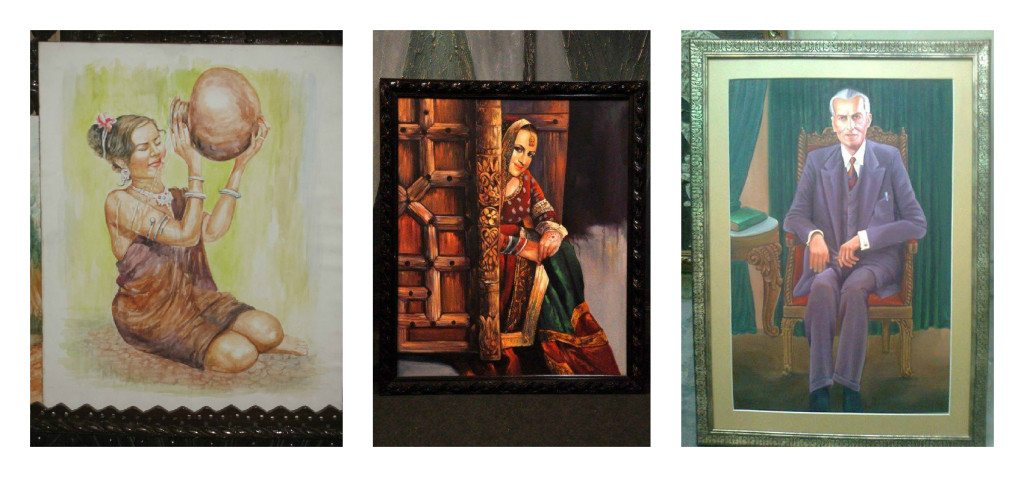
He takes me through to the room where the two men are sitting, and shows me some of his finest pieces. In my personal favourite, a lady rises angelically from a billowing dress, hands to the sky as if motioning for the world to rise together. In another portrait, Quaid-e-Azam Mohammad Ali Jinnah stares patiently out of the canvas, as if waiting for his dream to be realised. Couples sit by the ocean, a multi-armed woman rises from the darkness like a Hindu deity, Mughal emperors sit with their loves, tribesmen on horseback gallop past a modernist sphinx amid a desert scene.
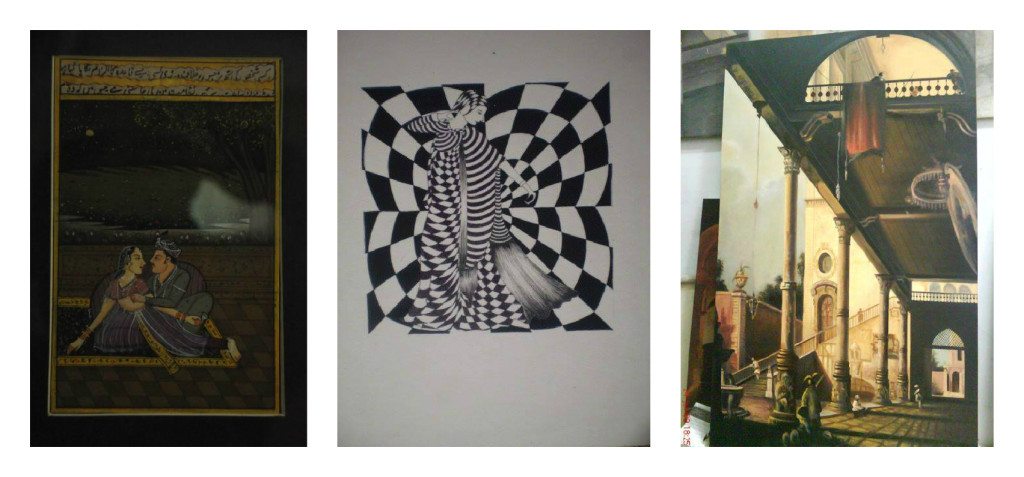
He places in front of me a couple of miniature paintings.
“My latest miniature paintings” he says. “They show the architecture and Islamic styles through colours and laser cutting. A mixture of shrines, calligraphy, festivals like Eid and Basant Bahara… artists such as Sadequain, Ustad Allah Bakhsh, Abdur Rahman Chughtai, (Ismail) Gulgee…”
“There is so much talent here” says a humble Bilal, referring to Pakistani artists generally, but perhaps not realising that we are surrounded by his own incredible masterpieces.
“Art is the beauty, it’s the way that you express your thinking to the world, it’s a hidden message, it’s a big reality, and a nude reality, like history – it’s bold.”
These are certainly interesting times to be an artist in Pakistan, and our country needs people like Mr Bilal Zuberi to depict and record the cultural history of the nation.


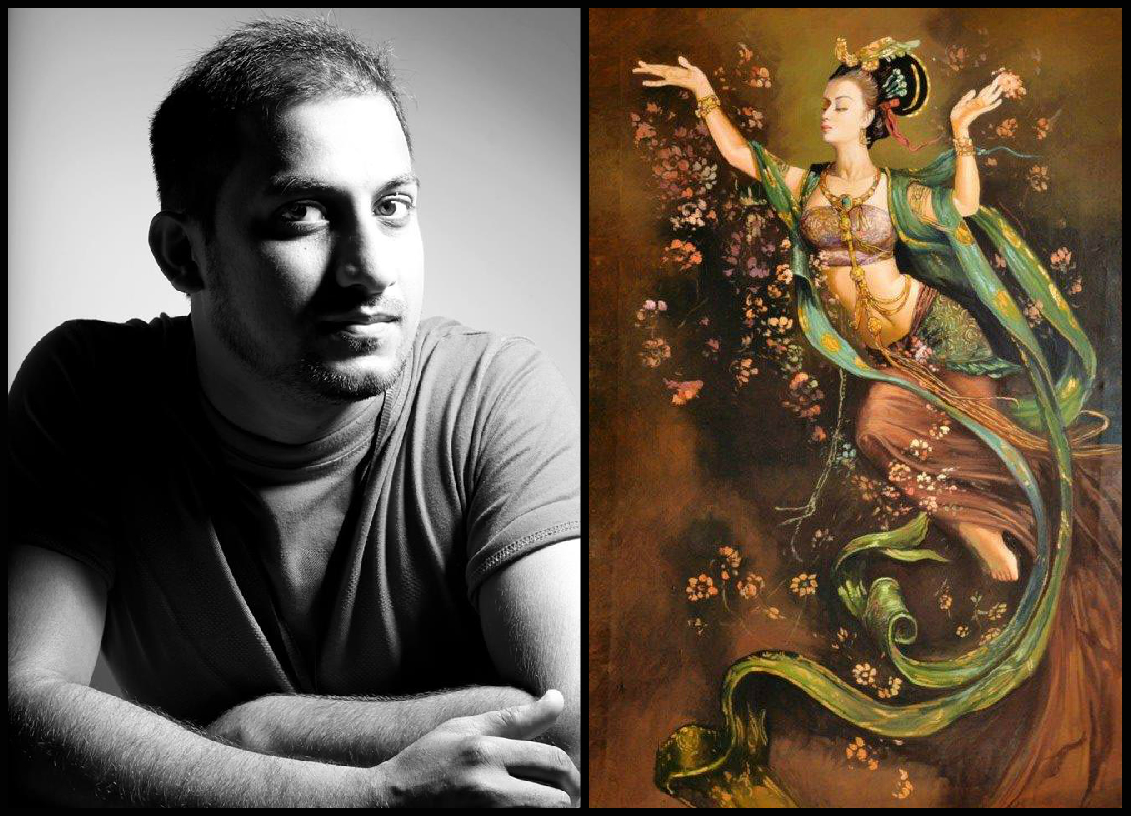
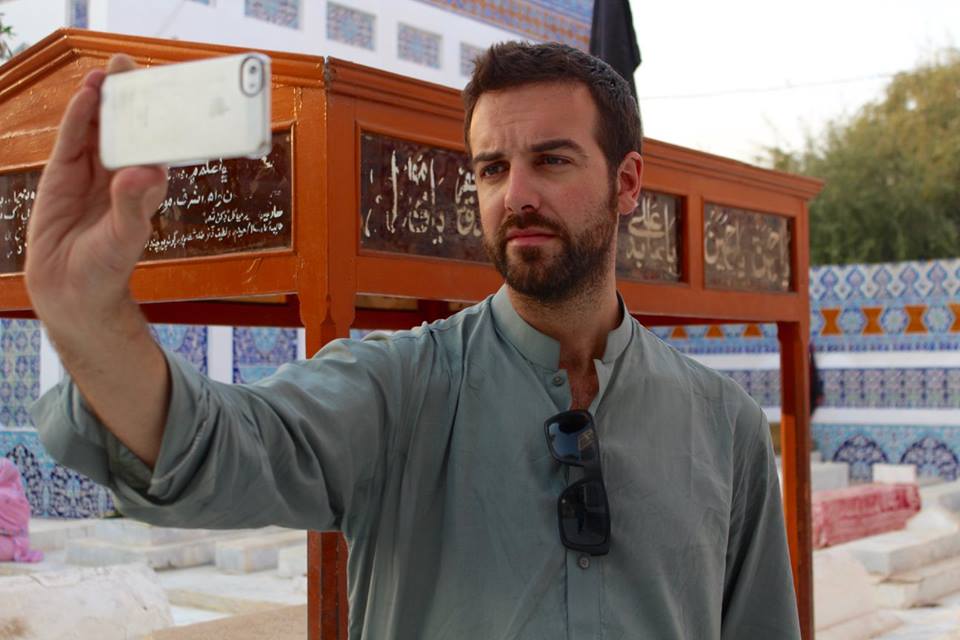

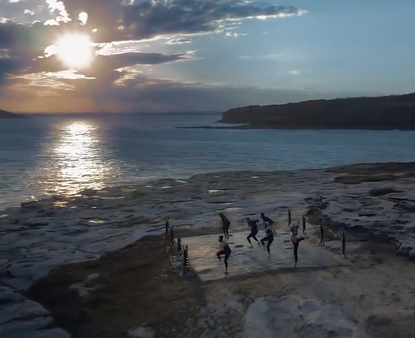
Great article Tim and what an honour to be given access to him for the interview. I love some of his work particularly the Islamic calligraphy in the Mosques. Beautiful
Thanks mum! Yes, his work is quite simply, beautiful!! And he’s such a nice guy too 🙂
thanks for sharing Tim – amazing
Thanks for reading Andrew! Glad you enjoyed it 🙂
Far out Tim, that is amazing. What a treat to have access to someone so awesome. I do enjoy visiting your blog, I learn so much. Great interview my friend. 🙂
I was pretty glad about it too!! Bilal is a really cool guy, and I’m honoured to have been introduced to him 🙂 Thanks for reading, Anna 🙂
He Is really a talented man. Thanks for sharing Sir 🙂
Thanks for reading 🙂